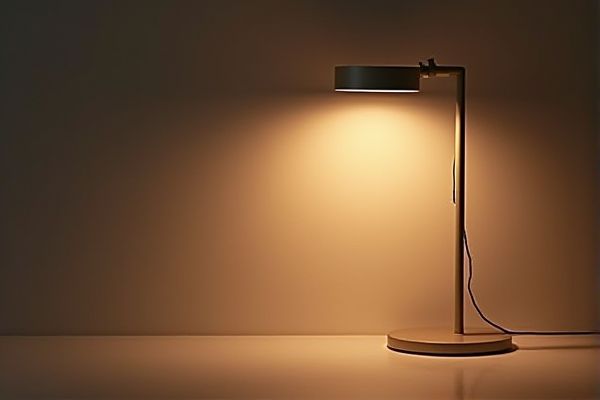
Telescoping lamps offer adjustable height and direction, providing versatile lighting solutions for various spaces, while fixed lamps maintain a constant position, ideal for consistent illumination needs. Discover which lamp type suits Your lighting preferences and space by reading the rest of this article.
Table of Comparison
| Feature | Telescoping Lamp | Fixed Lamp |
|---|---|---|
| Adjustability | Height and angle adjustable for customized lighting | Fixed height and angle, limited flexibility |
| Portability | Often portable and easy to move | Generally stationary, designed for a set location |
| Use Case | Ideal for task lighting, reading, and adjustable workspace lighting | Best suited for ambient lighting and fixed installations |
| Design | Sliding or extendable shaft, compact storage | Static design with no moving parts |
| Durability | Mechanical parts may wear over time | Typically more robust due to fixed construction |
| Price | Generally higher due to adjustable mechanism | Usually more affordable |
Introduction to Telescoping and Fixed Lamps
Telescoping lamps feature adjustable arms or extensions that provide versatile lighting angles, ideal for tasks requiring focused illumination. Fixed lamps offer a stable, non-moveable light source designed for consistent and reliable lighting in specific locations. Both types are essential in workspaces, with telescoping models enhancing flexibility and fixed lamps prioritizing durability and simplicity.
Key Differences Between Telescoping and Fixed Lamps
Telescoping lamps feature adjustable arms or poles that allow users to extend or retract the light source for flexible positioning, enhancing task-specific illumination and space efficiency. Fixed lamps have a rigid structure with a stationary light source, offering consistent lighting without customization or movement. The key differences revolve around adaptability, with telescoping lamps providing dynamic lighting control, while fixed lamps prioritize stability and simplicity.
Design and Construction
Telescoping lamps feature adjustable arms or stems that allow you to extend or retract the light source, offering versatility in height and angle for various tasks. Fixed lamps have a static design with a solid base and non-movable structure, providing consistent illumination without the need for adjustments. The construction of telescoping lamps often includes lightweight materials and jointed segments, while fixed lamps prioritize sturdy, durable builds for long-term stability.
Adjustability and Flexibility
Telescoping lamps offer superior adjustability with extendable arms that allow users to customize height and angle for optimal lighting in various tasks. Fixed lamps provide consistent, stable illumination but lack the flexibility to modify positioning, making them less adaptable to different lighting needs. The telescoping design enhances versatility in workspace lighting, while fixed lamps cater to environments requiring steady, unchanging light sources.
Space Efficiency and Placement
Telescoping lamps excel in space efficiency by allowing adjustable height and angle, making them ideal for small rooms or multi-purpose areas where flexibility in lighting placement is crucial. Fixed lamps offer a stable, predefined position that suits consistent lighting needs but can limit adaptability in tight or changing spaces. Your choice depends on whether you prioritize customizable illumination or a permanent, space-saving fit in your environment.
Illumination and Light Distribution
Telescoping lamps provide adjustable illumination, allowing you to customize light intensity and direction for targeted tasks or ambient lighting, enhancing usability in diverse settings. Fixed lamps offer consistent light distribution with stable brightness, ideal for uniform illumination but less flexible in adapting to specific lighting needs. Choosing between the two depends on whether you prioritize dynamic control of light patterns or reliable, steady illumination throughout a space.
Durability and Maintenance
Telescoping lamps feature adjustable components that may require more frequent maintenance to ensure smooth operation and prevent wear, potentially impacting overall durability. Fixed lamps, with their simpler, solid construction, generally offer enhanced longevity and require less upkeep, making them more reliable for long-term use. Your choice depends on whether you prioritize customizable lighting positions or a maintenance-free, durable fixture.
Aesthetics and Style Options
Telescoping lamps offer versatile aesthetics with adjustable height, allowing customized lighting angles that enhance modern and functional spaces. Fixed lamps provide a stable, consistent design ideal for traditional or minimalist decor, maintaining a steady style statement. Both lamp types come in various materials and finishes, enabling tailored integration with interior themes to elevate room ambiance.
Cost Comparison
Telescoping lamps typically cost more upfront than fixed lamps due to their adjustable design and added functionality. Fixed lamps, being simpler and less versatile, offer a more budget-friendly option with lower maintenance expenses. Your choice depends on whether the investment in flexibility justifies the higher price of a telescoping lamp for your specific needs.
Choosing the Right Lamp for Your Needs
Telescoping lamps offer adjustable height and direction, making them ideal for tasks requiring focused lighting, while fixed lamps provide stable, consistent illumination suited for ambient or decorative purposes. Your choice depends on whether you prioritize flexibility and targeted light or a steady, unobtrusive fixture. Consider your specific lighting needs, room layout, and usage patterns to select the lamp that enhances functionality and ambiance effectively.
 homyna.com
homyna.com